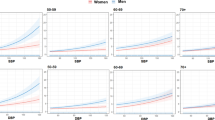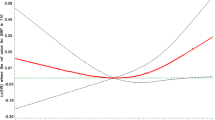Abstract
The classification of arterial hypertension (HT) to define metabolic syndrome (MS) is unclear in that different cutoffs of blood pressure (BP) have been proposed. We evaluated the categorization of HT most qualified to define MS in relationship with coronary heart disease (CHD) mortality at a population level. A total of 3257 subjects aged ⩾65 years were followed up for 12 years. MS was defined according to the criteria of the National Education Cholesterol Program using three different categories of HT: MS-1 (systolic blood pressure (SBP) ⩾130 and diastolic blood pressure (DBP) ⩾85 mm Hg), MS-2 (SBP ⩾130 or DBP ⩾85 mm Hg) and MS-3 (pulse pressure (PP) ⩾75 mm Hg in men and ⩾80 mm Hg in women). Gender-specific adjusted hazard ratio (HR) with 95% confidence intervals (CI) for CHD mortality was derived from Cox analysis in the three MS groups, both including and excluding antihypertensive treatment. In women with MS untreated for HT, the risk of CHD mortality was always significantly higher than in those without MS, independent of categorization; the HR of MS was 1.73 (CI 1.12–2.67) using MS-1, 1.75 (CI 1.10–2.83) using MS-2 and 2.39 (CI 3.71–1.31) using MS-3. In women with MS treated for HT, the HR of CHD mortality was significantly increased only in the MS-3 group (1.92, CI 1.1–2.88). MS did not predict CHD in men. In conclusion, MS can predict CHD mortality in elderly women with untreated HT but not in those with treated HT; in the latter, PP is the most predictive BP value.
This is a preview of subscription content, access via your institution
Access options
Subscribe to this journal
Receive 12 digital issues and online access to articles
$119.00 per year
only $9.92 per issue
Buy this article
- Purchase on Springer Link
- Instant access to full article PDF
Prices may be subject to local taxes which are calculated during checkout



Similar content being viewed by others
References
Wilson PW, Kannel WB, Silbershatz H, D'Agostino RB . Clustering of metabolic factors and coronary heart disease. Arch Intern Med 1999; 159: 1104–1109.
World Health Organisation. Definition, diagnosis and classification of diabetes mellitus and its complications. Report of a WHO Consultation. Part 1: Diagnosis and Classification of Diabetes Mellitus. Geneva: WHO, 1999.
Expert Panel on Detection, Evaluation, and Treatment of High Blood Cholesterol in Adults. Executive summary of the third report of the National Cholesterol Education Program (NCEP) expert panel on detection, evaluation, and treatment of high blood cholesterol in adults (Adult Treatment Panel III). JAMA 2001; 285: 2486–2497.
Ford ES, Giles WH, Dietz WH . Prevalence of the metabolic syndrome among US adults: findings from the third National Health and Nutrition Examination Survey. JAMA 2002; 287: 356–359.
Lakka HM, Laaksonen DE, Lakka TA, Niskanen LK, Kumpusalo E, Tuomilehto J et al. The metabolic syndrome and total and cardiovascular disease in middle-aged men. JAMA 2002; 288: 2709–2716.
Isomaa B, Almgren P, Tuomi T, Forsen B, Lahti K, Nissen M et al. Cardiovascular morbidity and mortality associated with the metabolic syndrome. Diabetes Care 2001; 24: 683–689.
Ford ES . The metabolic syndrome and mortality from cardiovascular disease and all-causes: findings from the National Health and Nutrition Examination Survey II Mortality Study. Atherosclerosis 2004; 173: 307–312.
Hunt KJ, Resendez RG, Williams K, Haffner SM, Stern MP . National Cholesterol Education Program versus World Health Organization metabolic syndrome in relation to all-cause and cardiovascular mortality in the San Antonio Heart Study. Circulation 2004; 110: 1251–1257.
Malik S, Wong ND, Franklin SS, Kamath TV, L'Italien GJ, Pio JR et al. Impact of the metabolic syndrome on mortality from coronary heart disease, cardiovascular disease, and all causes in United States adults. Circulation 2004; 110: 1245–1250.
Girman CJ, Rhodes T, Mercuri M, Pyorala K, Kjekshus J, Pedersen TR et al. The metabolic syndrome and risk of major coronary events in the Scandinavian Simvastatin Survival Study (4S) and the Air Force/Texas Coronary Atherosclerosis Prevention Study (AFCAPS/TexCAPS). Am J Cardiol 2004; 93: 136–141.
Anderson RN, Smith BL . Deaths: leading causes for 2001. Natl Vital Stat Rep 2003; 52: 1–85.
Balkau B, Charles MA . Comment on the provisional report from the WHO consultation. European Group for the Study of Insulin Resistance (EGIR). Diabet Med 1999; 16: 442–443.
Casiglia E, Palatini P . Cardiovascular risk factors in the elderly. J Hum Hypert 1998; 12: 575–581.
Mazza A, Pessina AC, Tikhonoff V, Pavei A, Privato G, Casiglia E . Pulse pressure: an independent predictor of coronary and stroke mortality in elderly females from the general population. Blood Pressure 2001; 10: 205–211.
Casiglia E, Tikhonoff V, Mazza A, Piccoli A, Pessina AC . Pulse pressure and coronary mortality in edlerly men and women from general population. J Hum Hyperten 2002; 15: 611–620.
Cockcroft DW, Gault MH . Prediction of creatinine clearance from serum creatinine. Nephron 1976; 16: 31–35.
Nicoll SR, Sainsburg R, Bailey RR, King A, Frampton C, Elliot JR . Assessment of creatinine clearance in healthy subjects over 65 years of age. Nephron 1991; 59: 621–625.
Alberti KG, Zimmet P, Shaw J, IDF Epidemiology Task Force Consensus Group. The metabolic syndrome-a new worldwide definition. Lancet 2005; 366: 1059–1062.
Kahn R, Buse J, Ferrannini E, Michael S . The metabolic syndrome: time for a critical appraisal. Joint statement from the American diabetes association and the European association for the study of diabetes. Diabetes Care 2005; 28: 2289–2304.
Balkau B, Charles MA . Comment on the provisional report from the WHO consultation. European Group for the Study of Insulin Resistance (EGIR). Diabet Med 1999; 16: 442–443.
American College of Endocrinology Task Force on the Insulin Resistance Syndrome. American college of endocrinology position statement on the insulin resistance syndrome. Endocr Pract 2003; 9: 236–252.
Casiglia E, Tikhonoff V, Mazza A, Pessina AC . Systolic and pulse hypertension. Aging Health 2005; 1: 1–9.
Alexander CM, Landsman PB, Teutsch SM, Haffner SM . NCEP-defined metabolic syndrome, diabetes, and prevalence of coronary heart disease among NHANES III participants age 50 years and older. Diabetes 2003; 52: 1210–1214.
Saad MF, Lillioja S, Nyomba BL, Castillo C, Ferraro R, De Gregorio M et al. Racial differences in the relation between blood pressure and insulin resistance. N Engl J Med 1991; 324: 733–739.
Shen BJ, Todaro JF, Niaura R, McCaffery JM, Zhang J, Spiro III A et al. Are metabolic risk factors one unified syndrome? Modeling the structure of the metabolic syndrome X. Am J Epidemiol 2003; 157: 701–711.
Ferrannini E, Buzzigoli G, Bonadonna R, Giorico MA, Oleggini M, Graziadei L et al. Insulin resistance in essential hypertension. N Engl J Med 1987; 317: 350–357.
Pollare T, Lithell H, Berne C . Insulin resistance is a characteristic feature of primary hypertension independent of obesity. Metabolism 1990; 39: 167–174.
Rowe JW, Young JB, Minaker KL, Stevens AL, Pallotta J, Landsberg L . Effect of insulin and glucose infusions on sympathetic nervous system activity in normal man. Diabetes 1981; 30: 219–225.
Grundy SM, Hansen B, Smith SC, Cleeman JI, Kahn RA . Clinical management of metabolic syndrome report of the American heart association/national heart, lung, and blood institute/American diabetes association conference on scientific issues related to management. Circulation 2004; 109: 551–556.
Grundy SM, Brewer Jr HB, Cleeman JI, Smith Jr SC, Lenfant C . Definition of metabolic syndrome report of the national heart, lung, and blood institute/American heart association conference on scientific issues related to definition. Circulation 2004; 109: 433–438.
Chobanian AV, Bakris GL, Black HR, Cushman WC, Green LA, Izzo Jr JL et al. Joint national committee on prevention, detection, evaluation, and treatment of high blood pressure, national heart, lung, and blood institute, national high blood pressure education program coordinating committee: seventh report of the joint national committee on prevention, detection, evaluation, and treatment of high blood pressure. Hypertension 2003; 42: 1206–1252.
Tikhonoff V, Casiglia E . Metabolic syndrome: nothing more than a constellation? Eur Heart J 2007; 28: 780–781.
Wang J, Ruotsalainen S, Moilanen L, Lepisto P, Laakso M, Kuusisto J . The metabolic syndrome predicts cardiovascular mortality: a 13-year follow-up study in elderly non-diabetic Finns. Eur Heart J 2007; 28: 857–864.
Sonesson B, Hansen F, Stale H, Lanne T . Compliance and diameter in the human abdominal aorta: the influence of age and sex. Eur J Vasc Surg 1993; 7: 690–697.
Hickler RB . Aortic and large artery stiffness: current methodology and clinical correlations. Clin Cardiol 1990; 13: 317–322.
Jonason T, Henriksen E, Kangro T, Vessby B, Ringqvist I . Menopause is associated with the stiffness of the common carotid artery in 50-year-old women. Clin Physiol 1998; 18: 149–155.
Ledru F, Ducimetière P, Battaglia S, Courbon D, Beverelli F, Guize L et al. New diagnostic criteria for diabetes and coronary artery disease: insights from an angiographic study. J Am Coll Cardiol 2001; 37: 1543–1550.
Marroquin OC, Kip KE, Kelley DE, Johnson BD, Shaw LJ, Bairey Merz CN et al. Metabolic syndrome modifies the cardiovascular risk associated with angiographic coronary artery disease in women. A Report From the Women's Ischemia Syndrome Evaluation. Circulation 2004; 109: 714–721.
Menotti A, Kromhout D, Nissinen A, Giampaoli S, Seccareccia F, Feskens E et al. Short-term all-cause mortality and its determinants in elderly male population in Finalnd, the Netherlands, and Italy: the FINE Study. Finland, Italy, Netherlands Elderly Study. Prev Med 1996; 25: 319–326.
Hillier TA, Rizzo JH, Pedula KL, Cauley JA, Schwartz AV, Ensrud K et al. Increased mortality associated with the metabolic syndrome in older women with diabetes. Diabetes Care 2005; 28: 2258–2260.
De Backer G, Ambrosioni E, Borch-Johnsen K, Brotons C, Cifkova R, Dallongeville J et al. European guidelines on cardiovascular disease prevention in clinical practice. Third joint task force of European and other societies on cardiovascular disease prevention in clinical practice (constituted by representatives of eight societies and by invited experts). Arch Mal Coeur Vaiss 2004; 97: 1019–1030.
Acknowledgements
We thank miss Jillian Walton for kindly revising the paper.
Author information
Authors and Affiliations
Corresponding author
Rights and permissions
About this article
Cite this article
Mazza, A., Zamboni, S., Tikhonoff, V. et al. Pulse hypertension: a new component of the metabolic syndrome in elderly women?. J Hum Hypertens 21, 934–941 (2007). https://doi.org/10.1038/sj.jhh.1002245
Received:
Revised:
Accepted:
Published:
Issue Date:
DOI: https://doi.org/10.1038/sj.jhh.1002245



